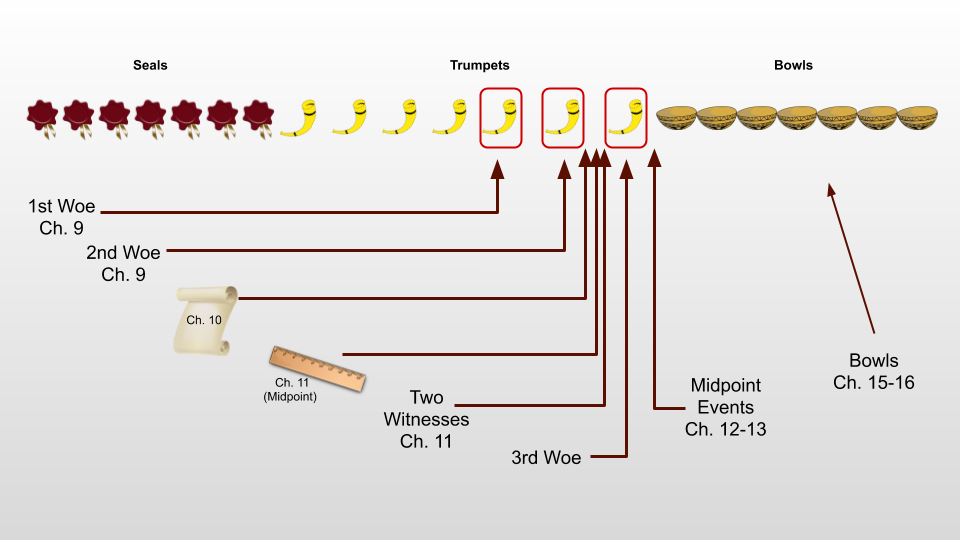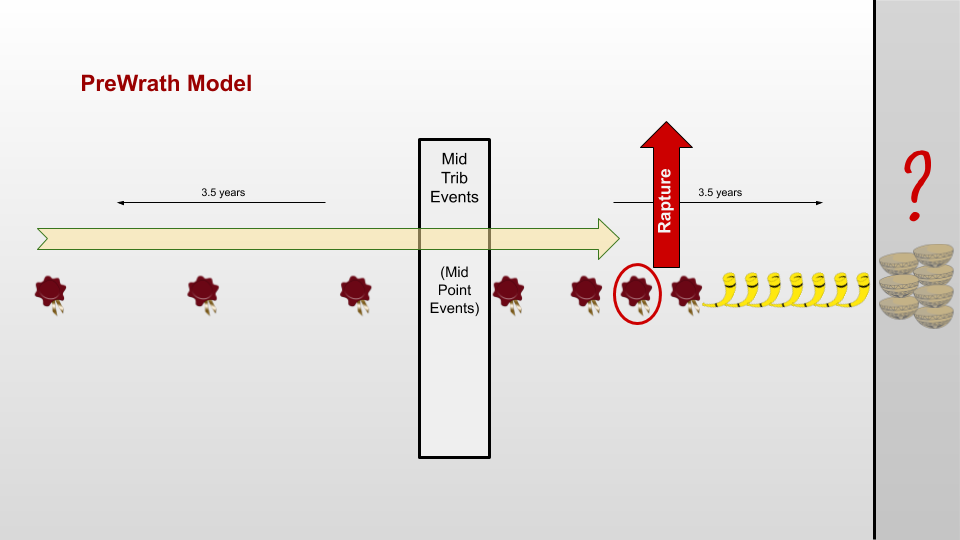When I was a young believer and out of my wits regarding Revelation and end times, someone gave me a tip: “Read Revelation chronologically and it will make sense.” That has proven to be an excellent tip!
The sequential structure of Revelation is already hinted at in its first chapter, with the words “Write the things which you have seen, and the things which are, and the things which will take place after this” (19). So right from the onset you have the structure of past, present and future. In addition, the words “after these things” and similar phrases are scattered throughout the book (4:1, 7:1, 7:9 ,9:12, 15:1, 15:5, 18:1, 19:1, 20:3, 20:7) showing its highly sequential nature.
Now, the common understanding of Revelation’s structure was that the Tribulation runs from chapters 6-19. This view was held pretty common to the varying rapture views, before Pre Wrath came on the scene and shuffled everything around. The view was that chapter 6 starts with the first judgments of the Tribulation and chapter 19 ends with Jesus tearing through the Heavens with His armies for the battle of Armageddon. The remaining chapters occur either before the Tribulation, in the preceding chapters, or after the Tribulation, in the subsequent chapters. This was quite simple and straightforward.
Here’s the basic structure of Revelation, commonly held:
- Opening in chapter 1
- Epistles to the Churches in chapters 2-3
- Prelude in Heaven before the judgments, in chapters 4-5
- Apocalypse starts in chapter 6, with a series of plagues or apocalyptic events unfolding, in 3 sets, ending with-
- Destruction of Babylon in ch. 17 to beginning of 19
- Christ’s glorious return and Armageddon in ch. 19
- Millennium, final rebellion and Great White Throne in chapter 20
- Eternity in Chapter 21
As part of the Apocalypse, chapters 6-16 contain 3 sets of judgments, administered in succession. Each set contains 7 judgments:
- Seven Seals
- Seven Trumpets
- Seven Bowls
It’s very simple.
For this article, it’s important to take note of the “Woe Judgments”.
What Are the Woe Judgments?
The Woe Judgments are the three last Trumpets.
Trumpet 5 = first Woe.
Trumpet 6 = second Woe.
Trumpet 7 = third Woe.
Simple enough.
When do the Woe judgments Occur?
Now we get to what I consider a major argument in favour of Pretrib. Later you’ll see why.
Please watch carefully how and where the Woe judgments are placed. Notice the sequence of events:
- Ch. 9, First Woe described (5th trumpet)
- Ch. 9:12: “One woe is past. Behold, still two more woes are coming after these things.”
- Ch. 9, Second Woe described (6th trumpet)
- Ch. 10, The little scroll
- Ch. 11, Midweek event described: Measuring the city and temple to be trampled for 42 months.
- Ch. 11, Midweek event described: The two witnesses die (starts or ends at midweek)
- Ch. 11:14: Warning for third Woe: “The second woe is past. Behold, the third woe is coming quickly”.
- Ch. 11, Third Woe described (7thtrumpet).
- Ch. 12-13, Midweek events described: Woman flees (midweek), 3½ year persecution starts (midweek), the beast speaking great things (midweek), making war with the saints for 42 months and controlling the world (midweek); the false prophet, the persecution of those who do not bear the mark (starts at midweek).
- Ch. 15-16, Prologue to and start of the seven Bowls
Here’s a diagram of how it looks:

And here’s the argument:
The Woe judgments are placed in between Midweek events (events that occur at the middle of the 70th Week, at the 3.5 year point). The wording and declarations before and after the Woes show very clearly that they are carefully interwoven with Midweek events, and cannot be shifted.
They’re written in this form:
Two Woes → Some Midweek events → Last Woe → Some more Midweek Events.
It follows that everything described in the chapters leading up to, and including, chapter 13, ends at the middle of the 70th Week. This includes all the Seals and all the Trumpets. They all end before the middle of the 70th Week, leaving the Bowl judgments to occupy the second half of the 70th Week.
The Significance for Pretrib
You might not at first be aware of the significance of this, but this is a major argument in favour of the Pretribulational rapture scheme. That’s because if both the Seal and Trumpet judgments occur before the midpoint of the 70th Week, that would make the first half of the 70th Week utterly catastrophic! It would mean that despite the increasing severity of unfolding judgments, it’s the first half that has most of the deaths of the 70th Week occurring in it, largely in only two of its judgments (4th Seal and 6th Trumpet). It would be impossible not to regard the first half of the 70th Week as God’s judgment and wrath. For anyone who thinks the Church has an exemption from God’s wrath, this would lend very strong support for a pre-tribulation rapture model.
Van Kampen and Rosenthal, who contrived the Pre Wrath rapture model, knew this very well. That’s why they wracked their brains to find another explanation for this clear marker and to shift things around, placing the judgments where they preferred them to be, in total disregard of the natural sequence that flows from a simple reading of Revelation. This re-shuffling resulted in their placing the last seven Bowl judgments in a 30 day period AFTER the 70th Week. Let me repeat that: Pre Wrathers place the last seven Bowl judgments AFTER the 70th Week is over. And that’s not all: as a result of this, Pre Wrathers also push the repentance of Israel and Armageddon to AFTER the 70th Week is over. It sounds unbelievable, it sounds twisted, it sounds absurd – but that is the PreWrath model.
Here is how PreWrath stretches out the seals and crams the bowls:

The PreWrath model, stretches the seals into the middle of the second half of the 70th Week, then crams the Bowl judgments to a 30 day period AFTER the 70th Week is over. This is done so that the 6th Seal can be placed somewhere in the middle of the second half of the 70th Week.
But despite all of Pre Wrath’s textual manoeuvering, it will not change one fact: the Woe judgments are immovable. The natural sequence of Revelation will not have them moved. Revelation has the last three trumpets placed in between the midweek events and nowhere else. The apostle John went to pains to pin those three judgments, to secure them, to anchor them just where they are. He wove the Woe judgments into the midweek events in such a way that you’d have to forcibly yank them out of context. You’d have to desire with all your heart, soul and mind, to see them placed elsewhere. And that’s exactly what the Pre Wrath founders have done. They’ve forcefully yanked the 3 Woe judgments out of their place among midweek events and shifted them to the end of the 70th Week to facilitate a Pre Wrath rapture model.
Conclusion
In contrast to Pre Wrath, Pretrib respects the sequentiality of the book of Revelation. In fact, It’s Revelation’s sequentiality that strengthens one’s belief in a Pretrib model. In other words, Pretrib lets Revelation tell its own story and lay things out for us as they happen. Any model that leaves Scripture in tact should be preferred.
===
Part 2 of this article will explain how Pre Wrath gets away with shifting the Woe judgments around.
Watch the Video Version
The thoughts represented in this article were previously produced into a 9 minute video – probably the most important video I made on the subject of Pretrib and Pre Wrath. Link: https://www.youtube.com/watch?v=el6Wg2JIRBA